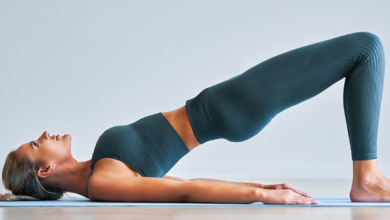4 Ways To Save Your Knees on Leg Day
Introduction – The Crucial Role of Healthy Knees
Leg day, a cornerstone of many fitness routines, is essential for building strength, endurance, and overall lower body fitness. However, the benefits of leg workouts can be compromised if you neglect the health of your knees. Knee injuries or discomfort can hinder your progress and even derail your fitness journey. Let’s explore four key strategies to safeguard your knees on leg day and ensure a strong and resilient foundation for your fitness pursuits.
The Importance of Knee Health in Leg Workouts
Before we delve into the strategies to protect your knees, it’s crucial to understand why knee health is paramount, especially on leg day. The knees bear a significant load during lower body exercises, and any weakness or instability can lead to discomfort, pain, or even injury. By incorporating smart strategies into your leg day routine, you can fortify your knees and support long-term joint health.
Perfecting Your Form – The Foundation of Knee Safety

Aligning for Success – Proper Form in Leg Exercises
One of the primary contributors to knee strain is improper form during exercises. Maintaining proper alignment is key to distributing the load evenly across your joints and muscles. Whether you’re squatting, lunging, or performing any leg exercise, focus on the following form principles:
- Maintain Neutral Spine: Keep your spine in a neutral position, avoiding excessive arching or rounding of the back. This ensures proper alignment and reduces stress on the knees.
- Knee Tracking: During movements like squats and lunges, ensure that your knees track in line with your toes. Avoid letting your knees collapse inward, as this can contribute to joint stress.
- Controlled Movements: Perform exercises with controlled, deliberate movements. Avoid rapid, jerky motions that can increase the risk of injury. Controlled movements not only protect your knees but also enhance the effectiveness of the exercise.
Exercise Modifications – Tailoring Workouts for Knee Health
If you’re experiencing knee discomfort or have a history of knee issues, modifying certain exercises can be a proactive approach. Consider the following modifications to protect your knees while still engaging your lower body muscles:
- Partial Range of Motion: Limit the depth of your squats or lunges to a range that is comfortable for your knees. This reduces stress on the joints while still providing an effective workout.
- Alternative Exercises: Substitute high-impact exercises with low-impact alternatives. For example, replace traditional lunges with reverse lunges or choose step-ups instead of jumping exercises.
- Seated Leg Press: If standing exercises cause discomfort, consider incorporating seated leg press variations. This minimizes the load on the knees while targeting the muscles of the lower body.
Strengthening Supporting Muscles – A Comprehensive Approach

Beyond the Knees – Strengthening the Surrounding Musculature
While leg day primarily targets the major muscle groups of the lower body, neglecting the supporting muscles can contribute to knee issues. Strengthening the muscles around the knees provides additional stability and protection. Focus on exercises that target:
- Quadriceps: Strengthening the quadriceps helps stabilize the knee joint. Leg extensions and leg presses are effective exercises for targeting the quadriceps.
- Hamstrings: Balanced strength between the quadriceps and hamstrings is crucial. Incorporate exercises like hamstring curls and deadlifts to enhance hamstring strength.
- Calf Muscles: The calves play a role in supporting the ankle and knee joints. Calf raises and other calf exercises contribute to overall lower leg stability.
Incorporating Stability Exercises
Include stability exercises in your routine to enhance the joint-supporting muscles. Balance exercises such as single-leg stands, stability ball exercises, and lateral leg raises can improve proprioception and stability around the knees. A strong foundation of supporting muscles contributes to overall knee health and reduces the risk of injury.
Embarking on a fitness comeback is a commendable decision that can positively impact both your physical and mental well-being. Whether you’re returning to exercise after a hiatus or overcoming a specific setback, a well-thought-out plan is crucial for a successful and sustainable comeback.
Mindful Warm-Up and Cool Down – Preparing and Repairing
The Power of Preparation – Warming Up for Leg Day
Properly warming up your muscles and joints before diving into leg day is a crucial step in preventing knee strain. A dynamic warm-up routine increases blood flow, enhances flexibility, and prepares your body for the demands of your workout. Prioritize dynamic stretches and movements that specifically target the muscles involved in your leg exercises.
- Leg Swings: Forward and side leg swings dynamically engage the muscles around the hips and knees, promoting flexibility and improved range of motion.
- Bodyweight Squats: Perform a few sets of bodyweight squats with controlled movements to activate the quadriceps, hamstrings, and glutes.
- Lunges with Rotation: Incorporate dynamic lunges with a rotational component to engage the muscles while enhancing mobility in the hip joints.
Cooling Down for Recovery
Equally important to a proper warm-up is a thorough cool down after your leg day workout. A cool down helps reduce muscle soreness, promotes flexibility, and supports joint recovery. Include static stretches that target the major muscle groups worked during your leg exercises.
- Quad Stretch: Standing or lying quad stretches help release tension in the front thigh muscles.
- Calf Stretch: Perform calf stretches against a wall or using a step to alleviate tightness in the calf muscles.
- Hamstring Stretch: Seated or standing hamstring stretches aid in maintaining flexibility and reducing post-exercise tightness.
Listen to Your Body – The Ultimate Guide to Knee Health
Tuning into Feedback – The Importance of Body Awareness
Perhaps the most critical aspect of preserving your knees on leg day is tuning into your body’s signals. Pay attention to any signs of discomfort, pain, or unusual sensations in your knees. If you experience persistent pain or discomfort, it’s essential to consult with a healthcare professional or a qualified fitness expert. Ignoring warning signs can exacerbate issues and lead to more severe injuries.
Smart Progression – Gradual Advancement for Joint Health
Avoid the temptation to push yourself too hard, too soon. Gradual progression in terms of weight, intensity, and complexity allows your joints to adapt and strengthen over time. Consistency in your leg day routine, coupled with smart progression, contributes to the long-term health of your knees.
Conclusion – Nurturing Your Foundation
In conclusion, leg day is a powerhouse for lower body strength and fitness, but it should not come at the expense of your knee health. By incorporating these four strategies—perfecting your form, strengthening supporting muscles, mindful warm-up and cool down, and listening to your body—you can safeguard your knees and promote a robust foundation for your fitness journey. Remember, the key to sustained fitness progress is not just the intensity of your workouts but the longevity of your commitment to overall joint health. With a thoughtful approach, you can enjoy the benefits of leg day while preserving the health and longevity of your knees.






